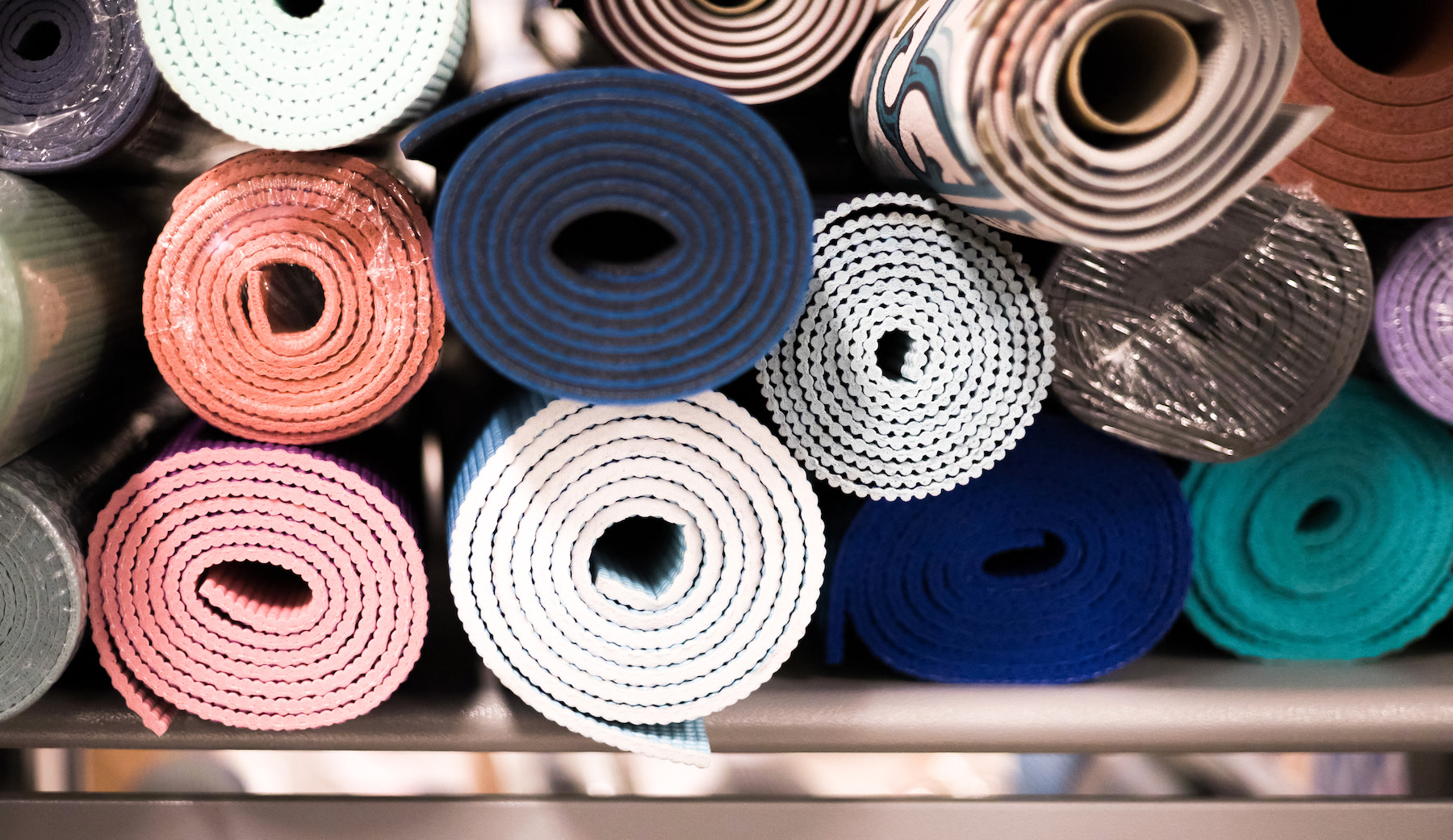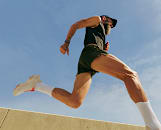
© Bisual Studio / Stocksy United
How to Clean a Yoga Mat, According to Experts
A routine cleaning is good for you and your mat—and it only takes a few minutes.
By Kylie Gilbert, Michele Ross•
Why You Need to Clean Your Yoga Mat
How Often Should You Clean a Yoga Mat?
Signs You Should Clean Your Yoga Mat
What You Need to Clean a Yoga Mat
How to Clean Your Yoga Mat
Can You Wash a Yoga Mat In the Washing Machine?
How to Dry and Store Your Yoga Mat
How Long Does It Take to Clean a Yoga Mat?
How Can You Keep Your Yoga Mat Cleaner for Longer?
The Takeaway
We get it: Cleaning your workout equipment after every use might seem like another chore you don’t have time for, especially on those days when it feels hard to find time for exercise in the first place.
Discover more ways to reach your goals with Peloton
But making sure your yoga mat is clean and ready to go for your next flow is not only a good habit for basic cleanliness; it can also help prevent skin infections and extend the lifespan of your mat. (And rest assured, it doesn’t take much time at all to clean.)
We talked to a microbiologist, a dermatologist, and a yoga instructor to learn how to clean a yoga mat properly. Keep reading to find pro tips that’ll help keep your health and your yoga mat in tip-top shape.
Why You Need to Clean Your Yoga Mat
It’s simple: You need to clean your yoga mat because it collects sweat, dirt, and odor over time, says board-certified dermatologist and yoga instructor Jennifer Chwalek, MD. There’s also the stuff you don’t see: “Bacteria, viruses, and mold/fungi can accumulate on yoga mats and increase our risk for skin infections,” she explains.
This can include bacterial skin infections such as folliculitis (which looks like inflamed papules and pustules similar to acne) or impetigo (a superficial skin infection that causes redness, vesicles, pustules, and crusting), warts, and fungal infections such as ringworm, Dr. Chwalek explains.
Unsurprisingly, this risk is higher if you’re using a shared yoga mat. Charles Gerba, PhD, a microbiologist at the University of Arizona, points out that studies have found a link between MRSA infections (also known as staph infections) and improperly sanitized fitness equipment, including yoga mats. This bacteria can cause infections that, in some cases, could be especially dangerous, he points out. But don’t panic: Other research suggests this isn’t incredibly common. Plus, “If you’re the only person using the mat, you have less risk of accruing an infection,” Gerba says.
Besides keeping your own health in check, regular cleaning is good for the quality of your mat too. “There’s evidence that certain groups of bacteria can degrade rubber products, so [failing to]regularly clean your mat may destroy it over time,” Dr. Chwalek says.
And of course, a clean yoga mat simply makes for a nicer environment to practice yoga. (No one wants to breathe in the smell of yesterday’s sweat when they’re in Savasana.)

How Often Should You Clean a Yoga Mat?
According to both Gerba and Dr. Chwalek, you should really clean your yoga mat after every time you use it. Gerba considers this a non-negotiable if the mat is being shared with others.
If you tend to get super sweaty and use your mat frequently, it’s a good idea to do a deeper clean once a week, Dr. Chwalek adds. The reasoning is pretty simple: “The more you are sweating on the mat and using it, the more potential for bacteria and dirt to accumulate,” she explains.
You might also want to clean your mat more often in the summer. As Dr. Chwalek points out, if you’ve been wearing sandals or open-toe shoes, you might not realize the extra dirt you’re tracking onto your mat. And if you’re in a crowded studio rather than using your mat at home, it’s more likely that other people will step on your mat with their potentially dirty feet too.
Signs You Should Clean Your Yoga Mat
It’s an especially good idea to clean your yoga mat if:
You worked up a sweat
You took a long or demanding yoga class
You’re using a shared mat at home or at a studio
You use it after walking around barefoot or wearing sandals
It has visible dirt, grime, or stains
It has an unpleasant odor
What You Need to Clean a Yoga Mat
What you use to clean your yoga mat is really dependent on the type of mat you have. “You should always refer to the manufacturer’s recommendations because if you use the wrong cleanser, you could possibly destroy the mat,” Dr. Chwalek says.
We’ll get into what cleaning method might be best for your specific type of mat, but in the meantime, here are some basic supplies to keep on hand:
Cleaning solution (DIY or store-bought)
Mild dish soap
Soft cloth
Towel
Disinfectant wipes (if preferred or to clean in a pinch, but double check if these are OK to use with your specific mat)
How to Create a DIY Yoga Mat Cleaner
If you want to make your own yoga mat cleaning solution, Dr. Chwalek recommends combining 1 part vinegar to 20 parts water, plus a few drops of tea tree oil (which has antimicrobial properties) in a spray bottle. (She suggests testing a small area of your mat first to see how it responds.)
Peloton instructor Kristin McGee has a similar go-to solution, which calls for a spray bottle of “mostly water, a cap full (or one to two spoonfuls) of tea tree oil, and a cap full (or one to two spoonfuls) of vinegar,” she says. “You can play around with the dilution, but this spritz is super clean and wonderful to use daily after you use your mat.”
What About Store-Bought Solutions?
If you’d rather buy a cleaning solution, many major yoga mat brands sell cleansers made with non-toxic products formulated for their mats, Dr. Chwalek says. Manufacturers typically don’t recommend traditional disinfectant wipes or sprays, as they can damage your mat and may not be the best to breathe in or lie on during practice.
At the same time, Gerba points to one recent study looking at the connection between MRSA and yoga mats, which found commercial cleaners with bleach are more effective than natural cleaning products. (That’s why experts at the Cleveland Clinic recommend using a chemical disinfectant for shared yoga mats, especially at the gym—but they note it’s not necessary for a personal mat.)
All in all, the solution you use might come down to your individual preferences, whether or not you’re sharing a yoga mat with others, and your mat’s specific care instructions.
How to Clean Your Yoga Mat
“How you clean your yoga mat is really dependent on the type of mat you have,” Dr. Chwalek reiterates. Yoga mats usually are composed of either natural rubber, PVC, cork, jute, or some combination of these materials, she says. Before cleaning your yoga mat, you’ll want to determine if it’s “closed-cell” or “open-cell”:
Closed-cell mats are typically made of materials that repel water and sweat, helping to reduce or prevent the absorption of moisture and bacteria, Dr. Chwalek explains. For this reason, they’re usually more durable and easier to clean. Examples of closed-cell mat materials include natural rubber, cork, TPE (thermoplastic elastomer), and recycled PVB (polyvinyl butyral).
Open-cell mats are typically textured and porous, so they’re able to absorb sweat and moisture. This makes them less slippery, but also less sanitary and harder to clean (and thus a better option for your at-home practice). These stickier yoga mats are typically made of latex-free PVC (polyvinyl chloride), otherwise known as vinyl, but jute is another popular eco-friendly, open-cell option.
With that in mind, here’s how to clean your yoga mat depending on the type of mat you have and the level of clean you’re after.
For a Quick, Post-Class Clean:
Roll out your mat.
Spritz the entire mat with the cleansing spray shared above, or wipe with a disinfectant wipe if preferred and approved for your mat.
Repeat on the other side.
For a Deep Clean (Closed-Cell Mat):
Fill a spray bottle or bucket with warm water and add a few drops of dish soap (about 1 tablespoon).
Spray the mat or apply soapy mixture with a soft cloth or microfiber towel.
Using the cloth, gently scrub the mat in a circular motion with soft cloth.
Rinse off soapy mixture.
For a Deep Clean (Open-Cell Mat):
Fill a bathtub with water to cover the mat and add a few drops of dish soap. (Make sure you check manufacturer instructions to confirm this method is safe for your mat.)
Submerge the mat in the soapy water and let it soak for a few minutes.
Using a soft cloth, gently scrub your mat with the soapy water.
Rinse the mat and squeeze out excess water.
Can You Wash a Yoga Mat In the Washing Machine?
It depends. Some yoga mats can be thrown in the washing machine, but you’ll want to check the manufacturer’s recommendations for your specific mat, Dr. Chwalek says. Some materials are susceptible to wear and tear in the machine. If you’re unsure, stick to hand-washing to avoid hurting your mat.
If the manufacturer says it is safe to machine-wash your yoga mat, Gerba suggests using hot water with at least a 15-minute cycle to make sure it’s properly disinfected. (However, if your mat suggests a cold, gentle cycle, defer to those instructions.)
If your mat is washer-safe, this is a great deep cleaning method to use in addition to per-use wipe-downs. “Once a month or so, I'll throw my mat in the washer on a gentle cycle and hang it dry,” Kristin says.

Catherine McQueen / Moment via Getty Images
How to Dry and Store Your Yoga Mat
After you’ve washed your yoga mat, there are a few best practices to remember come time for drying and storing.
1. Let It Air-Dry
After you wipe down or clean your yoga mat, be sure to let it air-dry completely. (Note that open-cell mats typically absorb water like a sponge and will take much longer to dry than closed-cell mats.)
Drying your mat before tucking it away is a key step: “Bacteria and viruses can live on yoga mats anywhere from several hours to several days, and fungi can survive on surfaces for months—especially if the environment is moist and damp,” Dr. Chwalek explains.
2. Roll and Store It Properly
Once your mat is totally dry, store it in a cool, dry place, Gerba and Dr. Chwalek say, since heat and moisture can create the right environment for microbial growth.
Proper storage could also extend your mat’s lifespan. It’s a good idea to keep your mat away from a window or radiator, especially if it’s made of natural rubber, cork, or jute, as Dr. Chwalek says these materials can dry out or deteriorate if exposed to direct sun or extreme heat. (She also recommends rolling a natural rubber mat so the rubber side is inside to protect it from degrading over time when exposed to sunlight.)
If you invest in accessories to store your mat, don’t forget to clean those regularly too. After all, you don’t want to undo all your hard work cleaning your yoga mat by storing it with or in anything dirty. “If you store it in a bag or with straps, make sure to wash these accessories occasionally so they don’t introduce dirt, odor, and microbes to your clean mat,” Dr. Chwalek says.
3. Consider Hanging It Up
“Another safe way to store and preserve your mat is to hang it up either with a gentle clip or fold it over a rod,” Dr. Chwalek says.”Some studios store mats this way.” Of course, this isn’t always possible at home—and perhaps the area can get dusty—so don’t overthink it.
How Long Does It Take to Clean a Yoga Mat?
Daily yoga mat maintenance only takes a few minutes, while a deep cleaning session could take 10–15 minutes (or about 15 minutes in the washing machine, depending on the cycle you choose), plus a few hours for it to dry. All in all, it’s a pretty minimal time commitment for your health and peace of mind.
How Can You Keep Your Yoga Mat Cleaner for Longer?
Want to level up your yoga mat’s cleanliness and improve its longevity? Here are a few tips from our experts:
Stay barefoot during your workout. Kristin recommends never wearing shoes on your mat to keep it cleaner and extend its lifespan.
Come prepared with clean hands and feet. This tip might seem obvious, but it’s important to always practice with clean hands and feet, Dr. Chwalek says.
Rotate your mat during your practice. While this tip is more for your mat’s longevity rather than its cleanliness, it ensures your feet aren’t always in the same place, Dr. Chwalek says. This can be especially helpful if you’re practicing on a natural rubber mat since they tend to wear out easier, she notes.
The Takeaway
It’s worthwhile to make cleaning your mat a regular part of your yoga practice. Luckily, cleaning a yoga mat doesn’t have to be difficult or time-consuming. Rather, doing so can extend the longevity of your mat and give you peace of mind so you aren’t worried about pathogens, odor, and other unpleasant distractions the next time you’re in Downward-Facing Dog.

Peloton App
Access thousands of classes with no equipment needed.
This content is for informational and educational purposes only and does not constitute individualized advice. It is not intended to replace professional medical evaluation, diagnosis, or treatment. Seek the advice of your physician for questions you may have regarding your health or a medical condition. If you are having a medical emergency, call your physician or 911 immediately.
Level up your inbox.
Subscribe for a weekly dose of fitness, plus the latest promos, launches, and events.
By providing your email address, you agree to receive marketing communications from Peloton.
For more about how we use your information, see our Privacy Policy.









